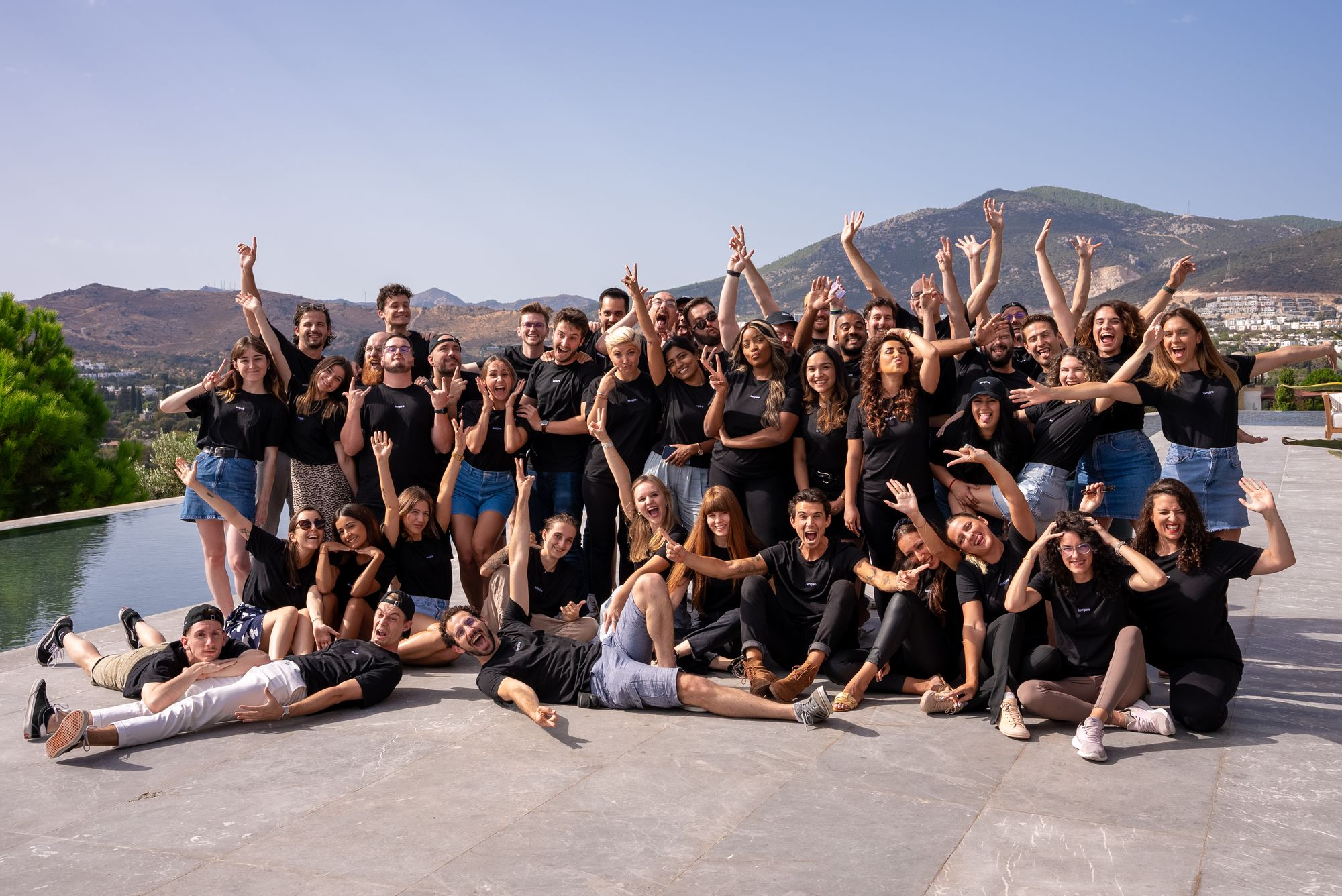December 2021, we just sold 20% of our business for $30,000,000 ($150m valuation).
After crossing $10m in Annual Recurring Revenue (ARR) without any funding, we were ready to skyrocket to $100,000,000 in ARR in the next 4 years.
But things didn’t go as planned.
My 2 co-founders left (for personal reasons), our head of growth & head of sales decided to start a new adventure, and our growth slowed down.
During the last 4 years, I've been writing about our journey in full transparency. Most of the time, it was to talk about how we managed to achieve crazy milestones in very little time - this article will be different.
Tough times are part of the most successful companies journey. They can either make you stronger or break you.
I want to detail how I’ve been navigating chaos as a CEO, the mistakes I’ve made during this process, and what are the next steps for lempire.
Navigating Chaos
When you’re growing a startup, Chaos is part of your day-to-day.
But when you try to go from startup to scale-up, you need to eliminate as much chaos as possible so you can really enter the SCALE phase.
This is usually when you start implementing more processes. The drawback of processes is that they often slow down your decision process...
From my experience:
Growth = Speed * Momentum
Speed is basically how quickly you go from idea to execution.
Momentum is how the market responds to your actions.
It's all the external factors that are telling you if what you're doing is working or not. When you have momentum it's like riding a wave or running downhill, moving forward is much easier.
So, when the recession hit earlier this year and I saw all VC-funded startup freezing hiring and laying off hundreds of people I didn't know what to expect...
But since we've always been highly profitable, I knew I could turn it into a growth opportunity.
To maintain our momentum, I wanted to hire more people, especially now that the talent pool was bigger (due to all the layoffs happening).
Growing the team
Growing a team is probably the hardest part of growing a company.
When you start, you hire people who are generalists - but when you scale, you need people with a whole new set of skills.
If you want to keep the same team, you need people who are growing faster than the company AND who also want to be part of a company that changes every 3-6 months.
From my experience, people would leave a fast-growing company for one of the 3 following reasons:
- The company’s goals and personal goals are not aligned anymore
- People are not growing as fast as the company
- Life event
The first 2 reasons can always be prevented or anticipated with transparent communication - but the 3rd one is unpredictable.
So what do you do when your 2 co-founders, your head of growth and your head of sales leave within a 6 months time frame?
First… you cry 😂
Then, like every challenge I faced in my entrepreneurial journey, I turned it into a new growth opportunity.
I listed all the things that I wanted to do differently at each level:
- I want the team to have a better vision of where we’re going in the next 3 years
- I want to invest heavily in product development and have a clear roadmap
- I want to help my top performers level up so they get the opportunity to take more responsibilities in the company
- I want to build a culture of ownership (where each person knows exactly their expectations and where each person is accountable)
- I want to stop being hands-on and become more of a leader (not a manager) - I need to become the CEO I wish I had.
Building a vision:
After having lunch with Emeric Ernoult (founder at Agorapulse) I understood the power of a 3-year vision:
Once you know where you want to be in 3 years, it’s much easier for you and the team to decide how to get there. Without a clear destination, how do you want your team to know which path to take?
So that’s what I did.
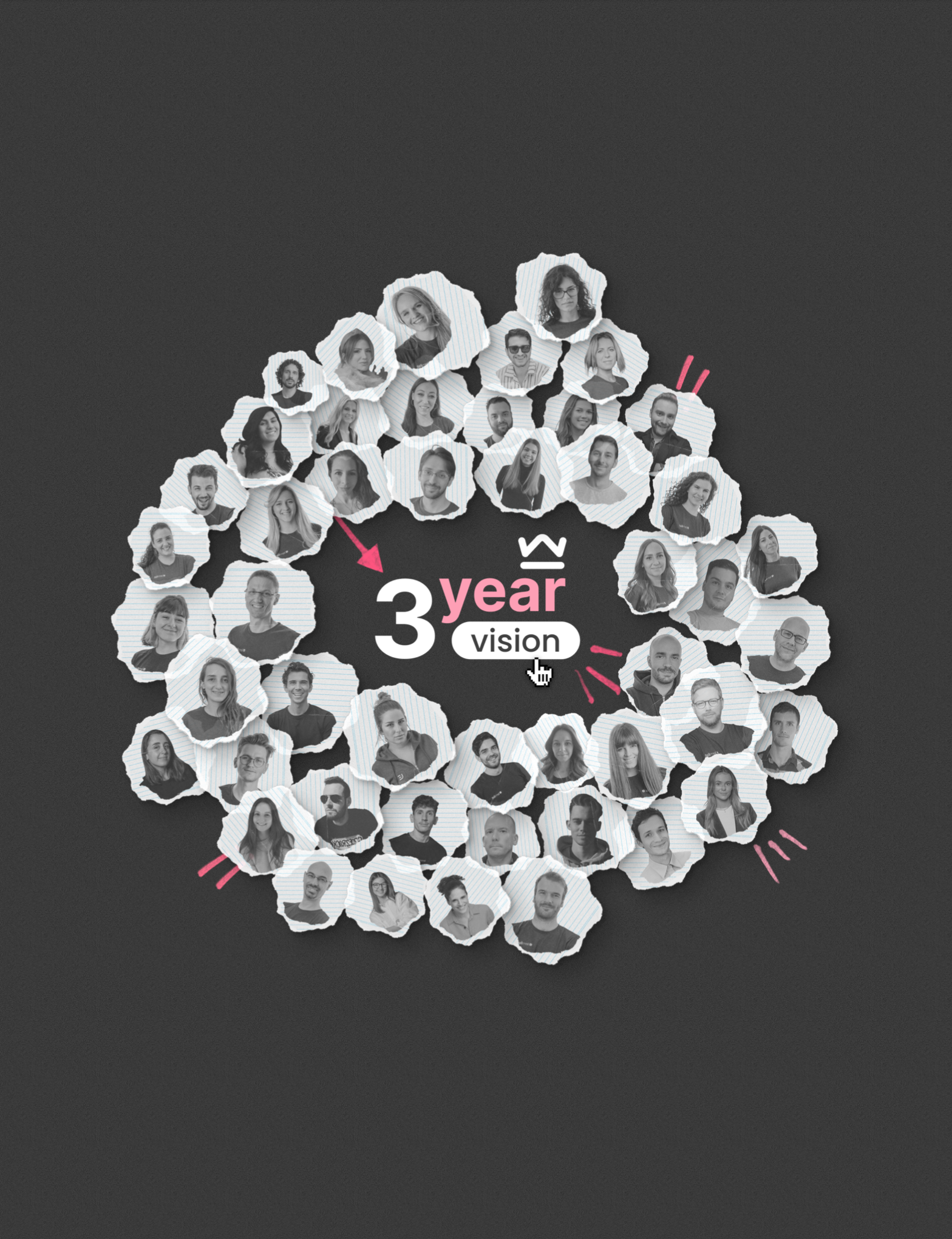
I divided the document into 5 parts:
- Context (Why do we need this document?)
- Vision (What are we going to achieve?)
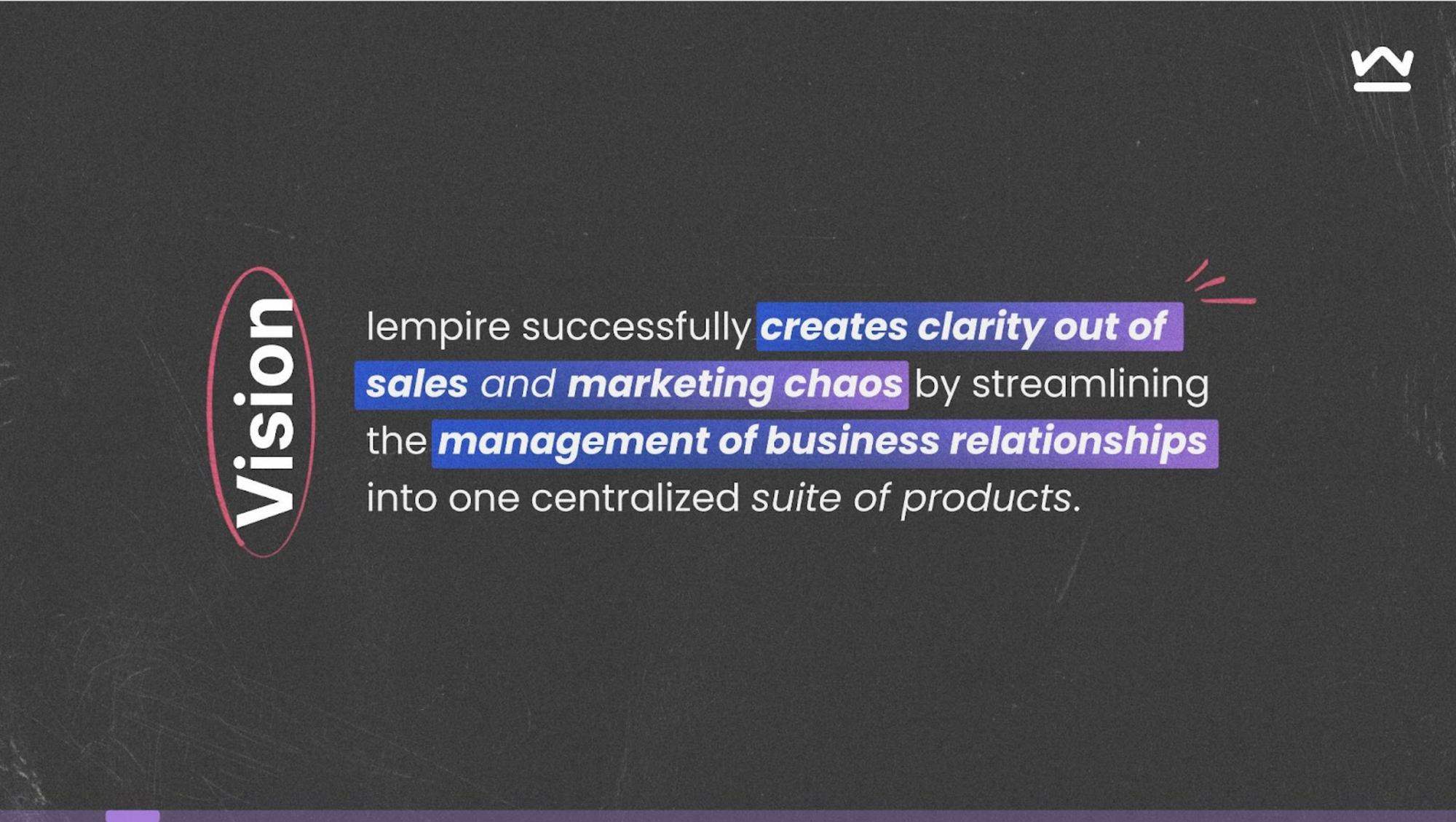
- Mission (How are we going to get there?)
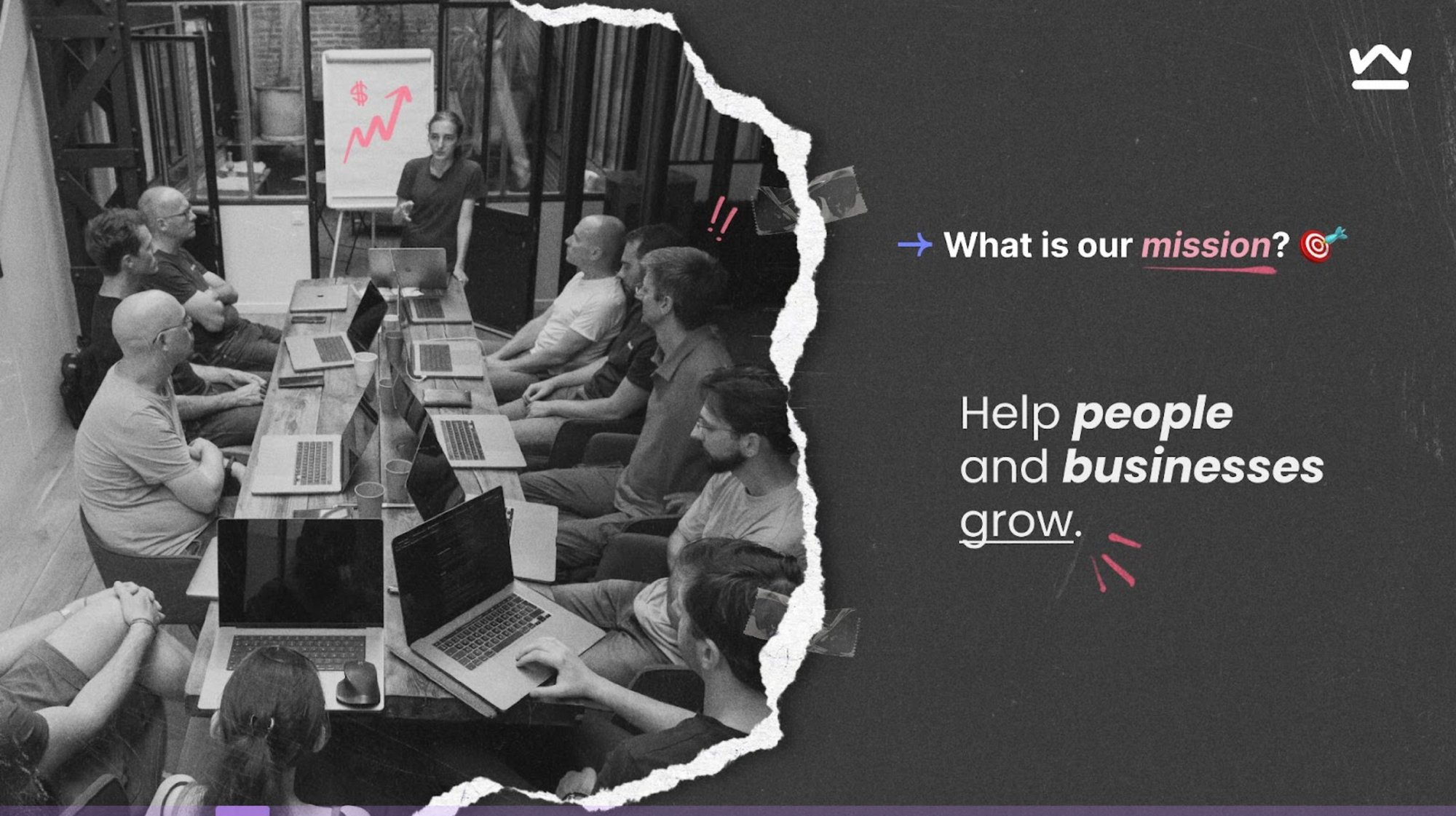
- Core values (What do we stand for?)
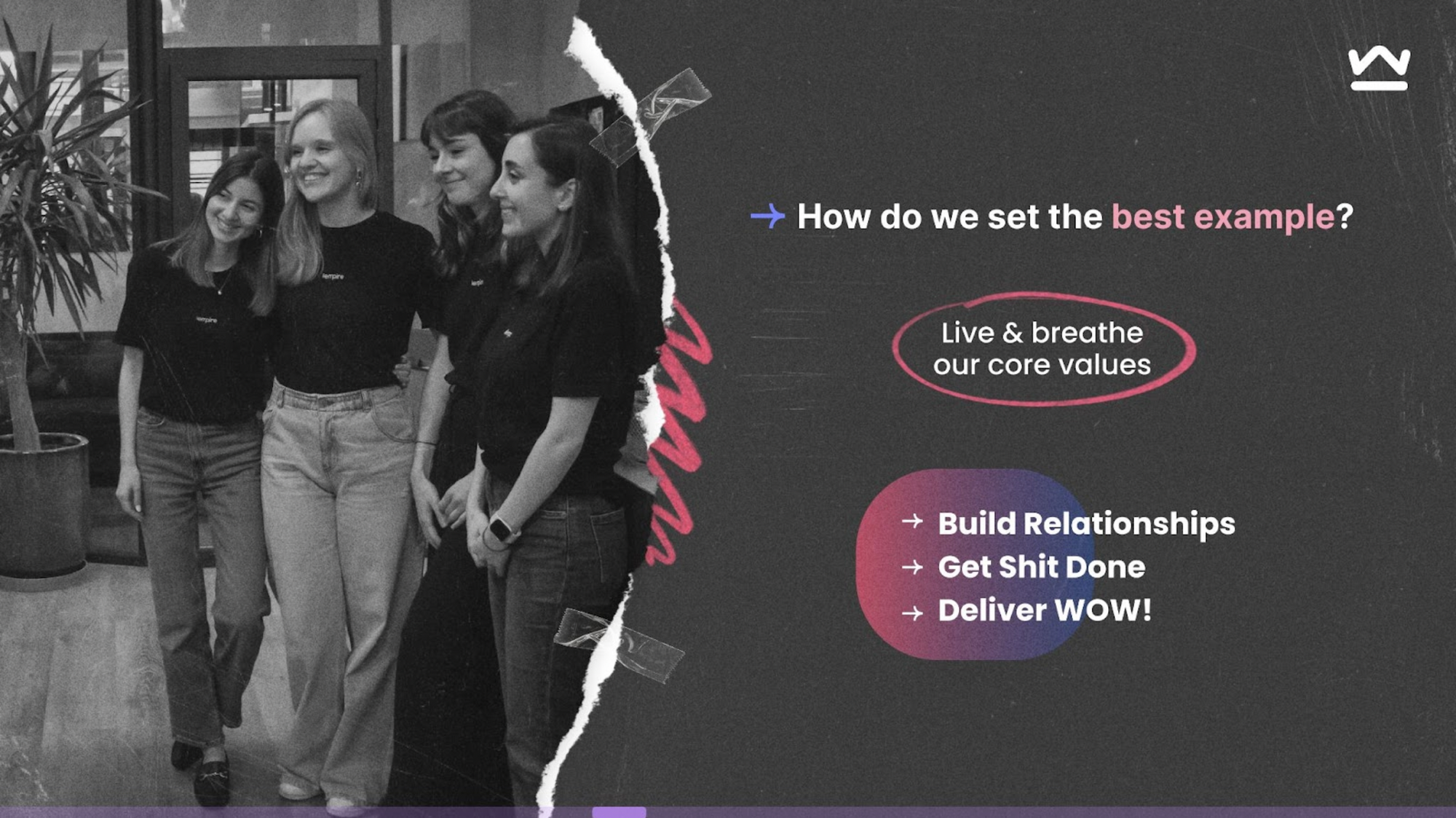
- Financials (How does that translate in terms of numbers?)

Numbers and financials help define clear objectives as a company. Money is, in my opinion, the best indicator of the success of a company. Why? Because the more money your company is making, the more people you're helping solve a problem worth paying for.
But most of the time it's difficult to know whether or not the projections are realistic. That's why I also added a slide based on the previous year.
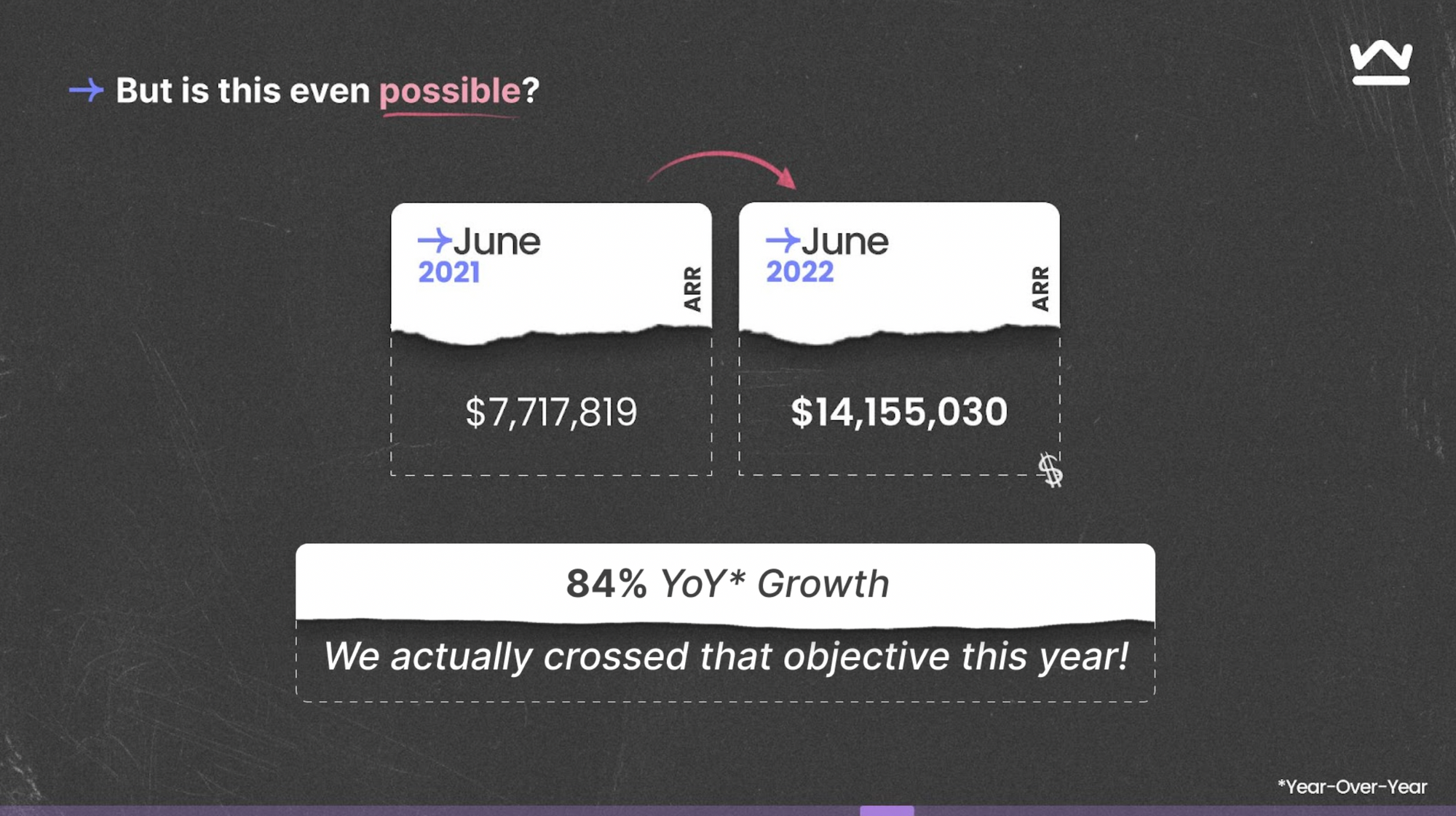
If you can show your team that you already crossed that objective once, it's much easier for people to project that it's doable in the future.
Once I had defined the vision and laid out the challenges, I decided that it was time to go organize a team retreat with all the team leads and work as a team to define how we were going to achieve that vision altogether.
I organized our retreat as follows 👇
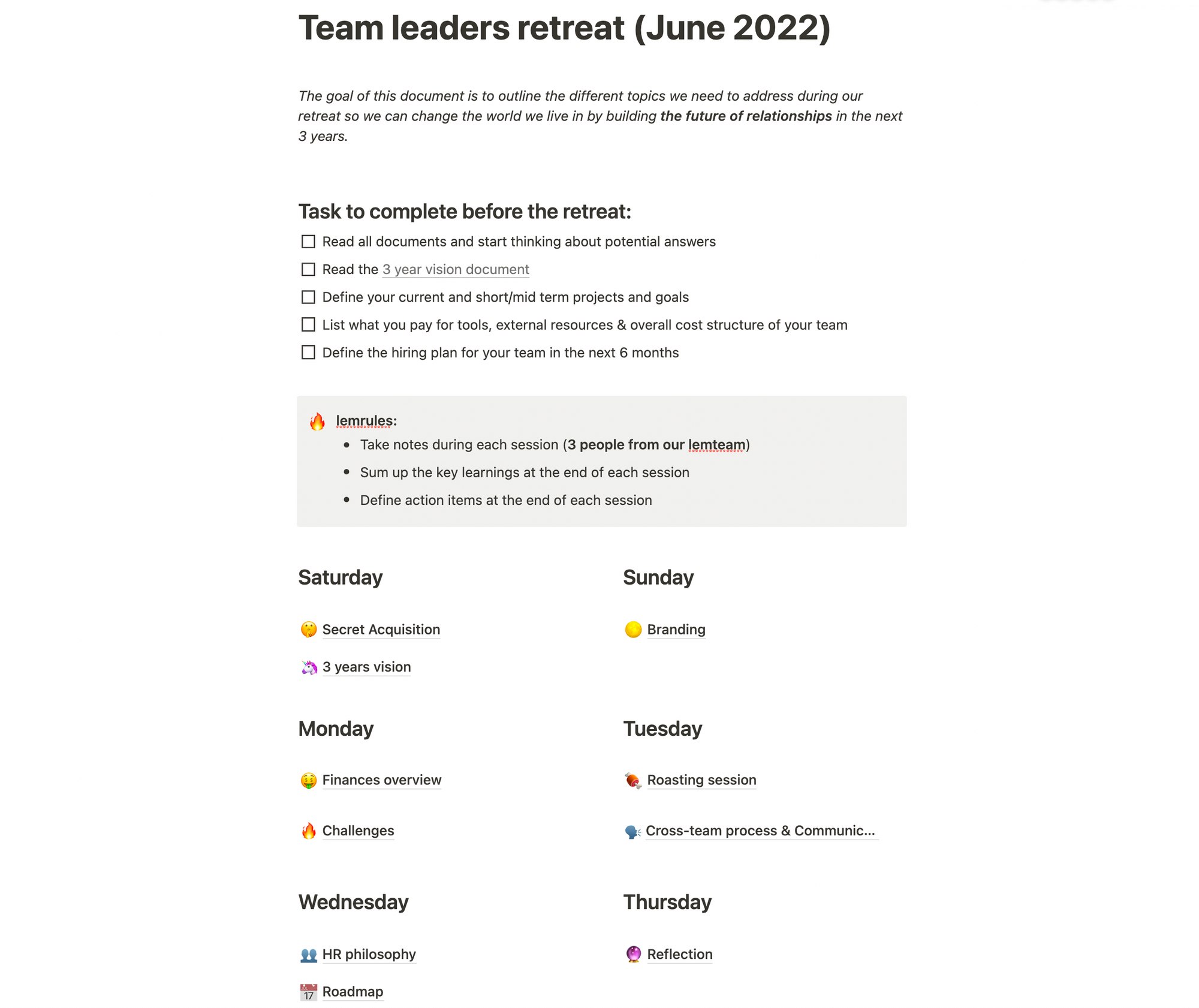
I planned each session in a super actionable way so we knew clearly the agenda and what would success look like at the end of each session.
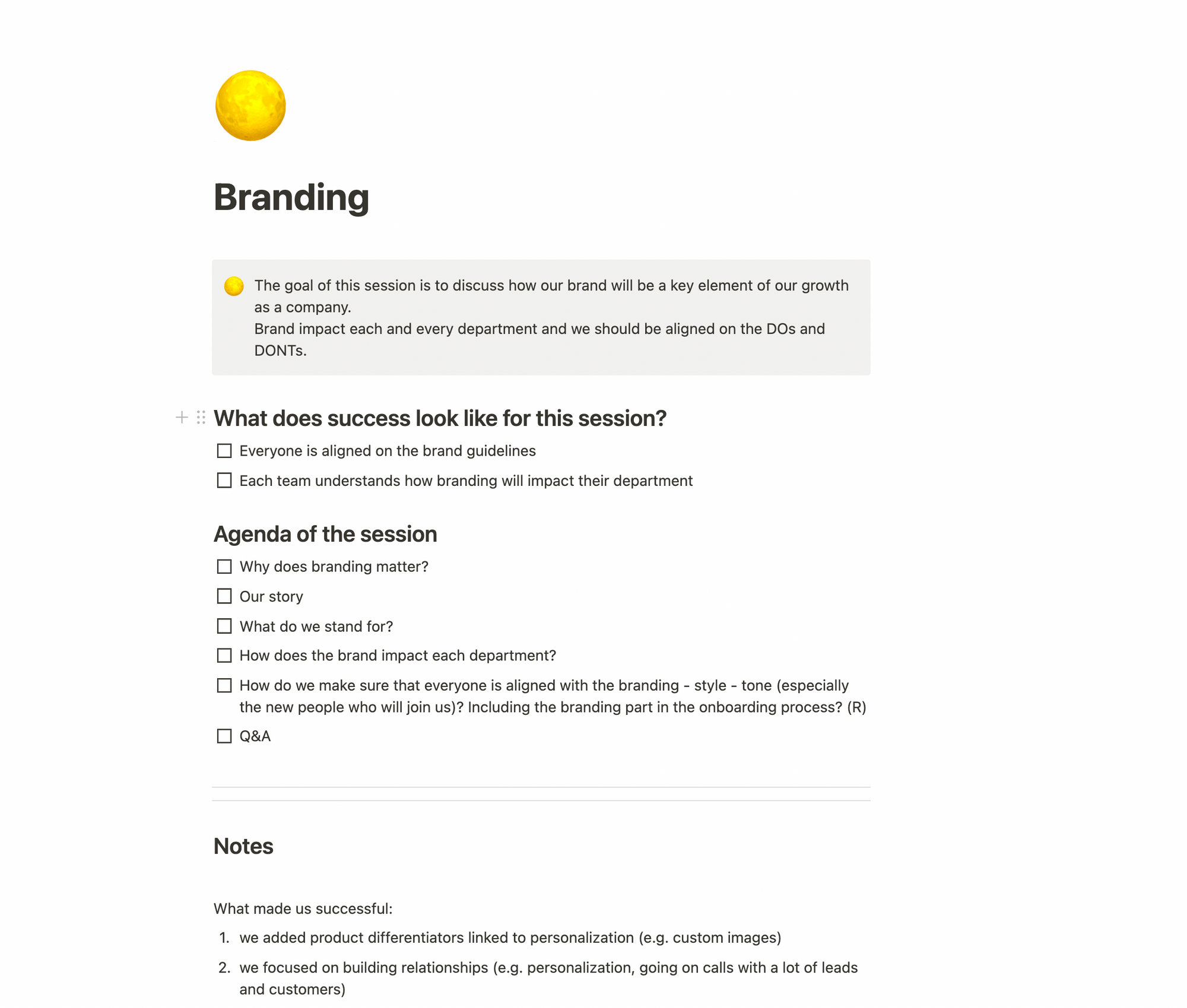
So we rented a big house in the middle of the countryside and worked there for a week in submarine mode.

We realized that we would have to invest heavily in the product, the team, the culture, and the growth to reach our 3-year goals.
Invest heavily in the product:
At the beginning of the year, we faced 2 main challenges: Technical debt and cross-team communication.
The technical debt is basically the price to pay when your top priority for the last 4 years was to ship features as fast as possible without a product team 😅
To remove the technical debt, you have to work A LOT on the foundation of the app so you can continue to scale. This means that you need to slow down the development of other features.
We took a lot of wrong decisions in the past and this year has been a real transition for us. For too long the dev team was working in silos with no real communication with other teams nor a clear roadmap… It was creating a lot of frustrations on all sides.
The dev team thought that their job was useless because the marketing/sales/support teams were not caring about what they were developing.
The marketing/support/sales teams were pissed off because they never had visibility on the roadmap and couldn’t plan their workload accordingly.
So how to fix this?
Remember Robin? The intern who got his full-time job by beating me during an arm wrestling context? On top of having arms the size of my legs, he's also a brilliant Product manager. So Matt (our new CTO) and Robin decided to work on clear processes, to align all the team.
Taking good product decisions requires taking them at the right time with the right inputs.
Here are the key inputs we use for making great product decisions:
- Product vision
- Product strategy
- User research
- Industry knowledge
- Available resources
- Instinct
We gather customer centric & industry aware feedback in 2 different ways:
- Inbound ⇒ Feedback coming from support, sales, our community, DMs ..
(example of inbound feedback from our lemverse Slack)
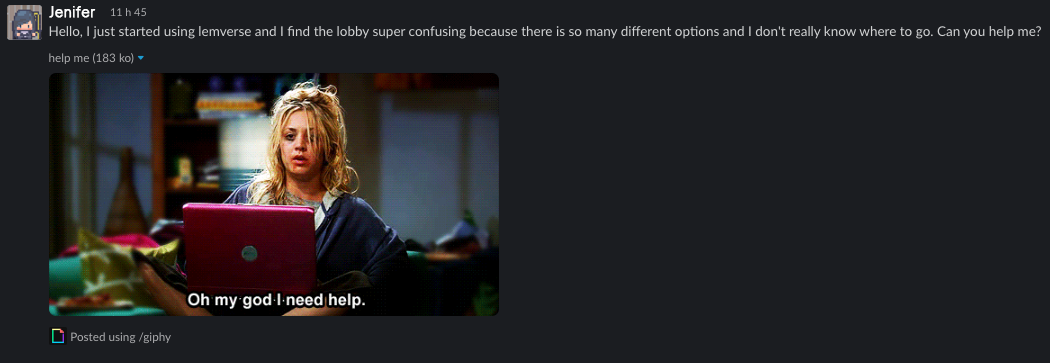
- Outbound ⇒ Product team doing interviews, surveys, market research, analytics studies, usability studies
Once we have identified a pattern from gathered insights we create what we call product opportunities.
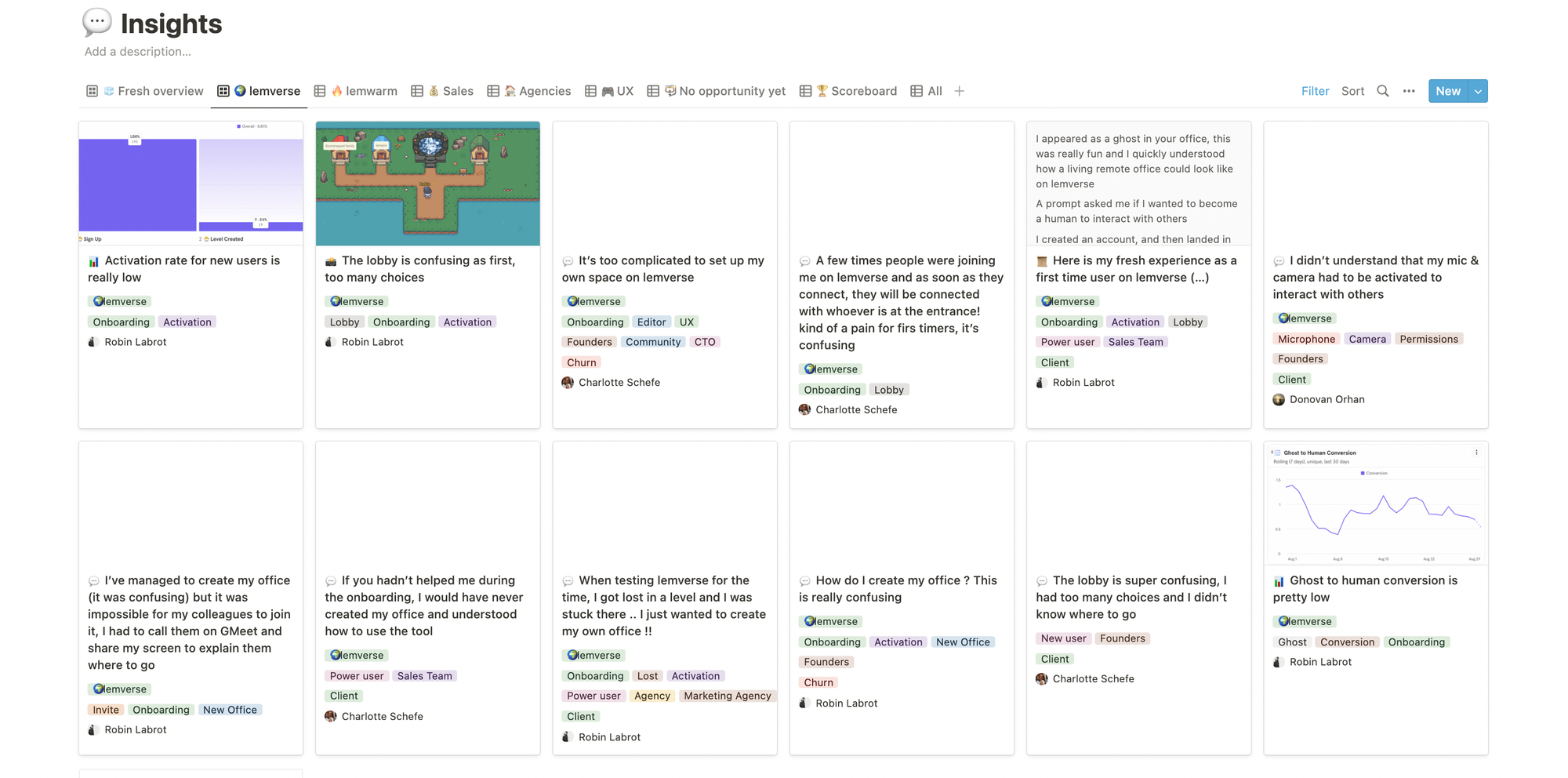
Basically, those are pain points, needs, desires of our users/leads, or ways to make them more successful
This is the starting point of a story, also called ticket in other companies

A story is a granular unit of work for the product team to work on.
We then select the stories to work on based on our current business objectives (OKRs).
Shaping ⇒ the story then enters the shaping phase, where we dig deep into the opportunity to define it correctly and start looking for potential solutions
Shaping should be as sharp as possible so that the design & dev teams can build the correct solution for the well define opportunity
The story then goes into a lot of steps until release 👇

Shaped ⇒ Story is ready for the dev & design teams to work on it
Ongoing ⇒ Currently building the content of the story
Align ⇒ Step to make sure the whole company is aligned and ready for launch (FAQ, newsletter, community ..)
This is a crucial step to improving company communication on the product changes
Check ⇒ We check if the release goes as planned.
The checking part is critical because each additional feature adds usage complexity and high maintenance costs.
This is why it’s crucial to unship when needed. This is a very hard step that a lot of companies are not willing to do most of the time
We constantly ensure we bring value to our users and make them successful by keeping our products intuitive and easy to use.
But for all of this to work, you need a capable and empowered team, and this is not limited to the product team.
Invest heavily in the team:
When you scale the first advice you get is: “hire people who have already done it”.
Personally, I’m still learning a lot and I’ve always preferred to allow people within the team to do the same.
I’ve always preferred to promote people internally and train them. There's a first time to everything and I want to give the opportunity for everyone on the team to become the best at what they're passionate about.
However, for too long I limited people's growth to my own.
As a CEO, my role has changed every 6 months. To grow to $10,000,000 in ARR I've been involved A LOT in the day-to-day. My mantra was to "lead with example". I wanted to become the best at everything so I could show the team how to do it.
But I realized that I was holding back everyone. Building a company is a people business. This means that as a CEO I need to do my best to put everyone in the team in the best possible conditions to level up and learn, but not necessarily from me.
During my journey, I made thousands of mistakes and that's how I learned. For years I protected the team from these mistakes by over-controlling everything. So I decided to Stop focusing on the "HOW are we going to get there".
I shifted my mindset to becoming a coach/leader and not a manager. But to become the best in what you do, you have to learn from the best.
That’s why I decided to hire a coach and buy courses and training for everyone on the exec team (including myself).
Investing in external coaching has really been a game changer for us as a team and that's something I really regret not doing earlier.
Here are a few things I did as a CEO:
- Took Christine Carillo's "20-hour CEO course" - it was an eye opener on the necessity to have an executive assistant as a CEO and how to regain control of your calendar
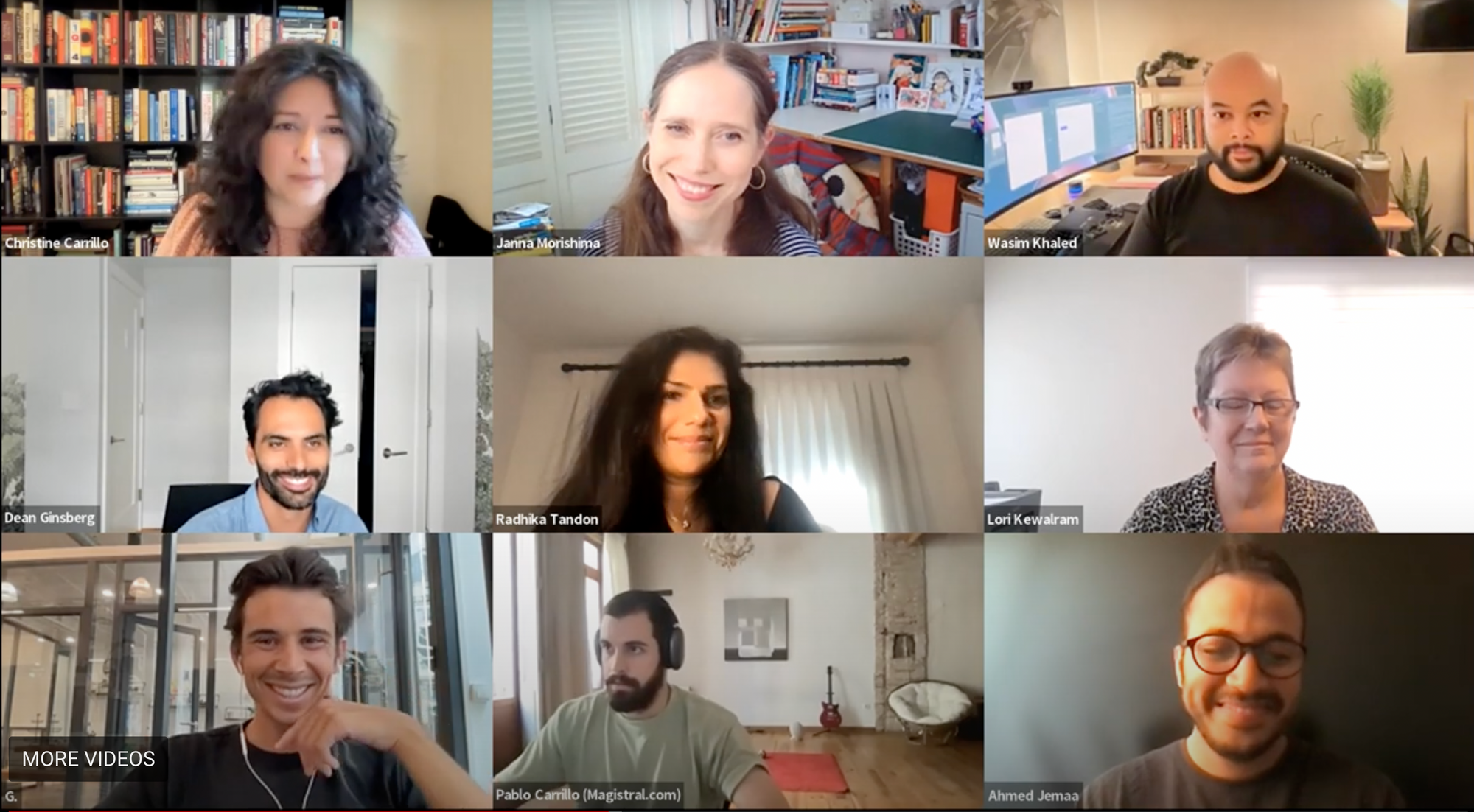
- I've been working with Pierre Verstraeten from at Scale to do a Leadership 360° review. It allows me to see where I currently stand as a leader (based on the current team feedback).
The higher the score on the top part of the leadership circle, the better.
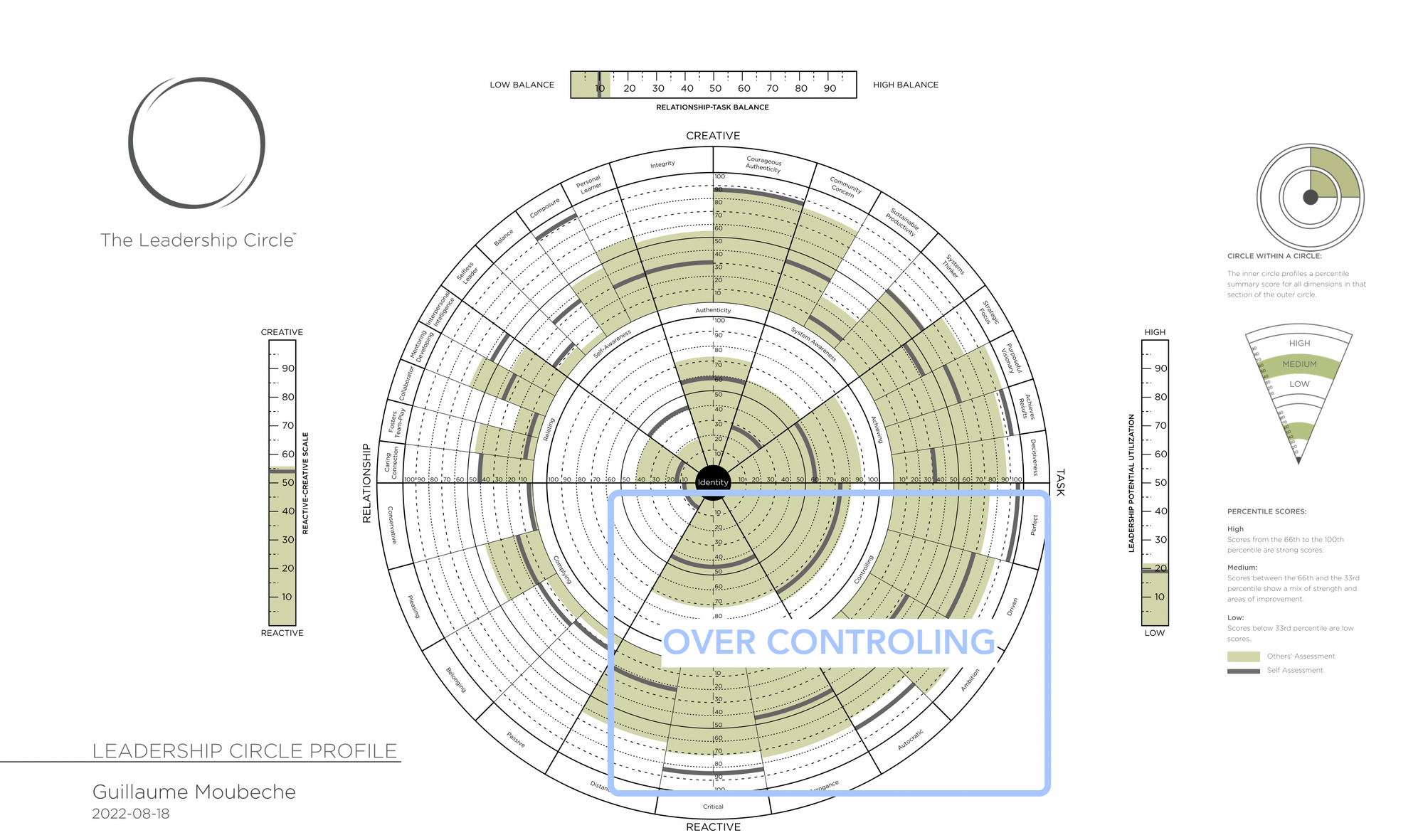
I'm scoring high on the bottom right of the circle which means that I've been over-controlling the team and doing too much micro-management. This ultimately blocks me to score high on the top left part of the circle which is the part where you allow your team to reach their highest potential as individuals.
Thanks to this data it was easy for Pierre and me to know on where to focus our work.
Investing in a culture of ownership
The more you want to delegate as a CEO or manager, the more you need people to be owners of their topics.
That's where OKRs (Objectives, & Key Results) are super helpful. Essentially it gives you clear directions on what you need to accomplish. OKRs are first defined at a company level, then department level, and finally at a personal level.
The problem with OKRs is that you need to keep things simple and make sure that it's part of the entire culture so you build more accountability in each team.
That was Simon's and Lucille's mission. Making sure to design a place where we could visualize all our OKRs so the whole company is up to date with what we're working on.
Because Notion is our knowledge center and project workspace, we wanted to keep as much information there and avoid multiplying the number of tools we’re using.
After 8 weeks of working with a specialized agency (Optemization), we gave everyone access to the company objectives and projects.
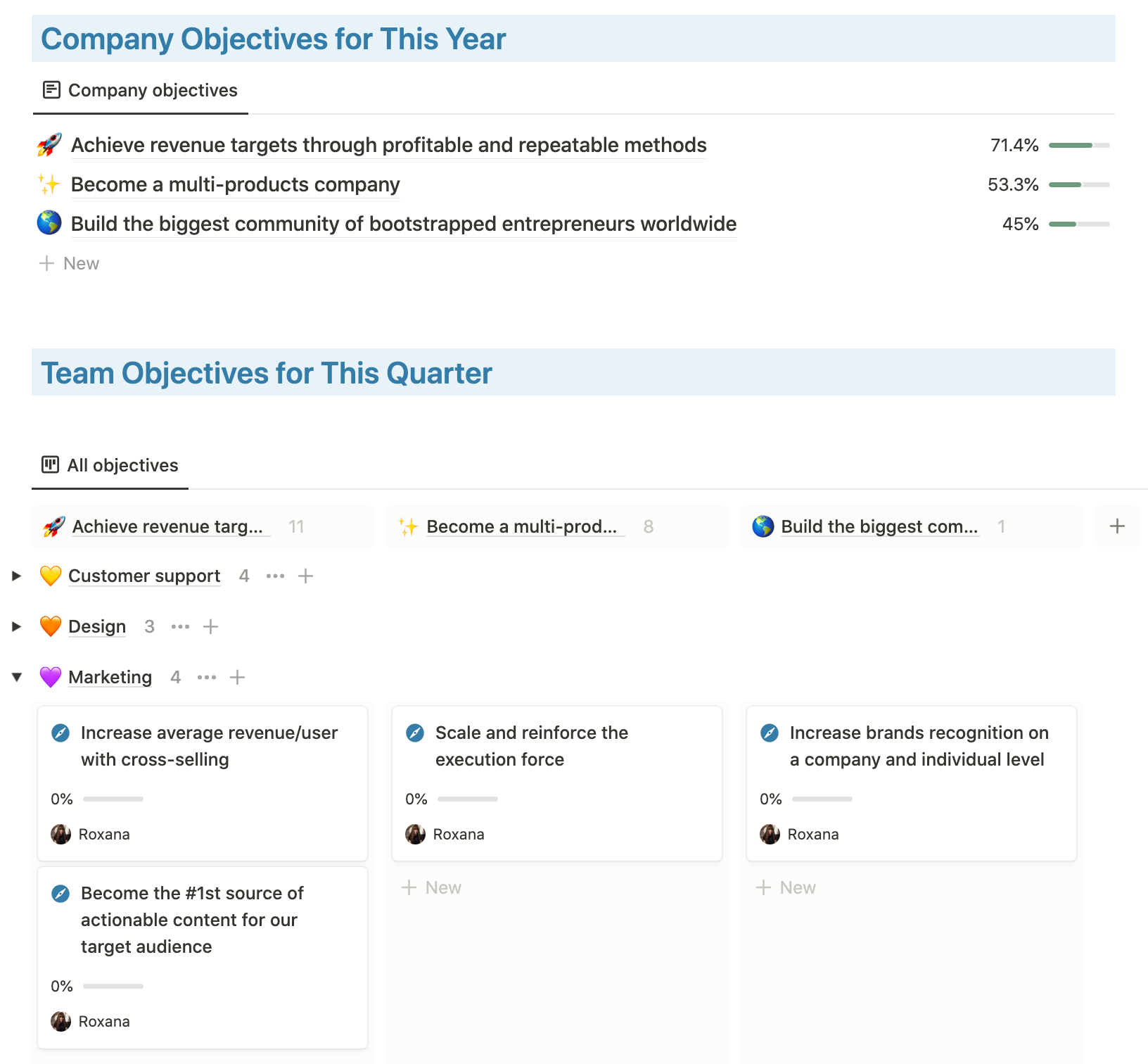
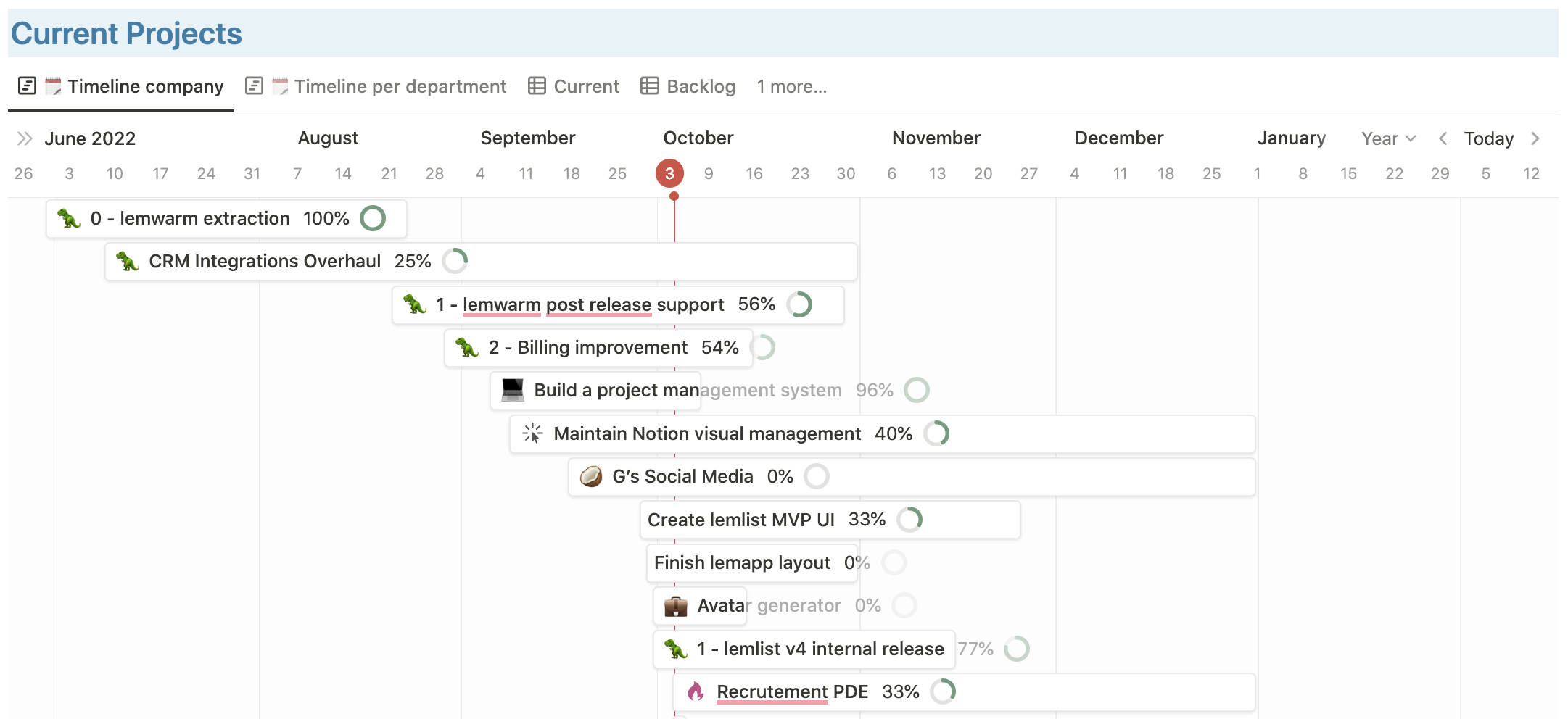
Each team member also has a personal dashboard where they can update their key results and task progress. This is extremely useful to track your impact and where you're at during this quarter.
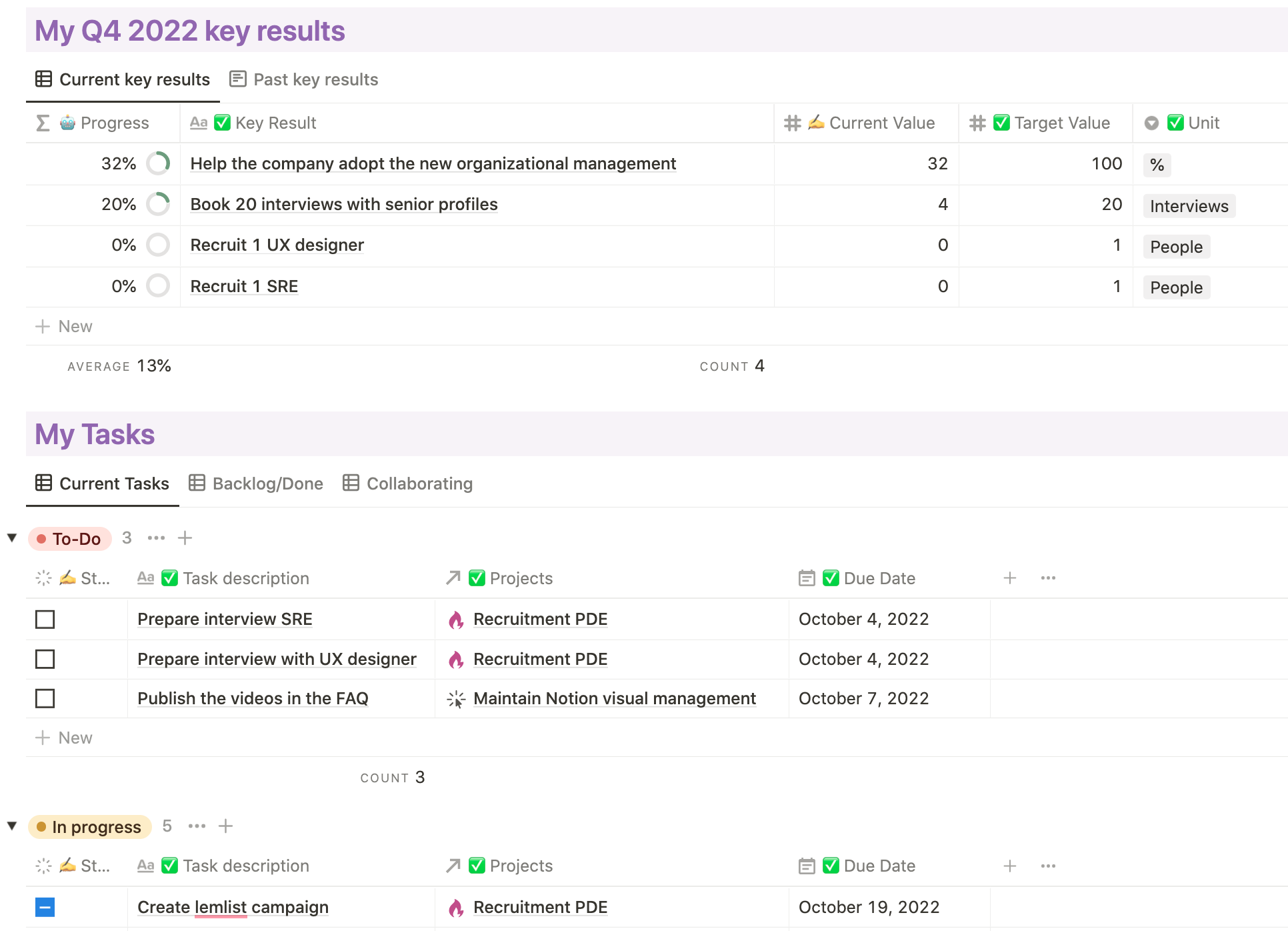
To go more in detail, every project has a complete overview with the purpose, events, and useful links.
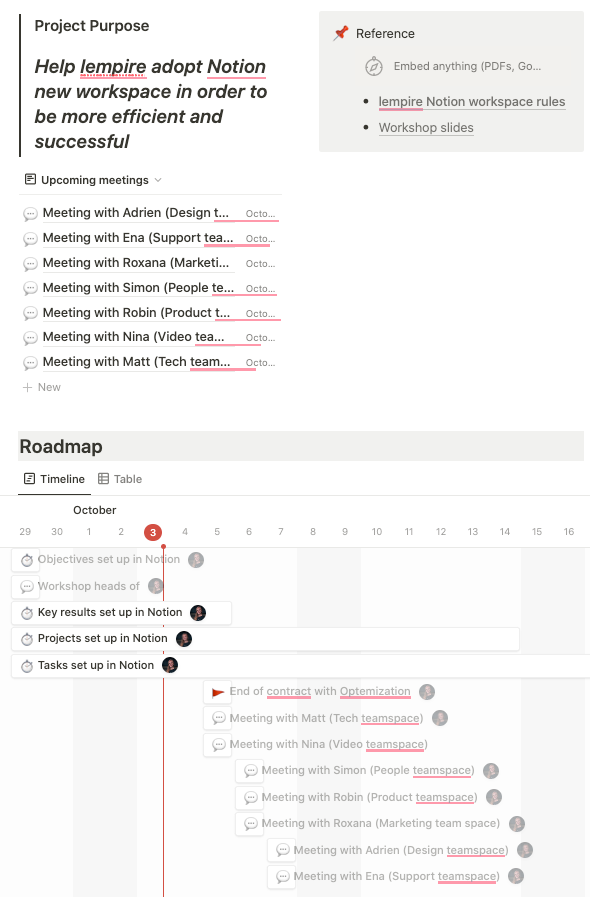
For a better transition to the new organization, we also have created planning of the adoption phase (OKRs set up, project set up, etc.) and we created an FAQ.
The goal is to make sure everyone is autonomous and responsible.
Investing in our growth
For more than 3 years we had a 2-digit month-over-month growth rate. So when we started to see our growth rate slows down a little we just thought that we needed to find new ways to acquire more customers.
Looking for new strategies and acquisition channels is super exciting. Because it's new. And as an entrepreneur, I LOVE what's new. But as Alex said 👇
Nine times out of ten, to grow a business you need to do “more” or “better”, rarely “new.”
— Alex Hormozi (@AlexHormozi) August 22, 2022
After a few months, I realized that we got so excited by the NEW as a team that we forgot about the things that we were really good at, and that made us successful in the first place.
I also realized that our top of funnel (the number of new customers we're getting each month) was actually not the real problem: churn was.
Churn rate is basically the percentage of paying clients canceling their subscriptions on a monthly basis. For years we had a high churn rate but did not care too much about it for 3 main reasons:
1- Our target market.
We've been focusing on SMBs, startups, and scaleups which means that the churn rate is always a bit higher compared to other segments. Some businesses will stop their outreach during the year and come back, some will run out of business and churn, and others will simply go check our competitors because of a low switching cost...
2- Our Growth rate
For years we had 2 digits month-over-month growth rate with super low customer acquisition costs (and high profit) which means that our churn rate was actually not really slowing us that much (or at least that's what we thought).
3- Our long-term strategy.
We knew from the early days that we wanted to go upmarket to fuel our growth. For us, it was clear that with bigger teams it also meant more stickiness to our product and less churn. But to do so, we had to build a product that fits customer needs, and for too long we postponed the development of key features.
I personally feel that because we didn't put churn as our #1 priority for growth, we took a lot of wrong product decisions. When you have a leaking bucket, no matter how it leaks at some point you can't just keep pouring more water at the top - you have to fix the leak. That's exactly what happens with churn.
Was our reasoning for not caring too much about churn wrong? I don't think so. Some companies manage to keep a high churn and a high growth and become billion-dollar companies - but in our case, we know that this is something we have to fix if we want to scale to the next level.
The next steps
I love the quote:
Pressure bursts pipes or makes diamonds
After the first 9 months of this year, I can tell you that we're definitely not a pipe 💪💎
We are stronger than ever as a team and I feel like being able to lay out all our challenges allowed us to take crucial decisions as a team!
September was actually our record month in the history of lemlist and we added almost 1,000,000€ in net new ARR in just a month 🚀
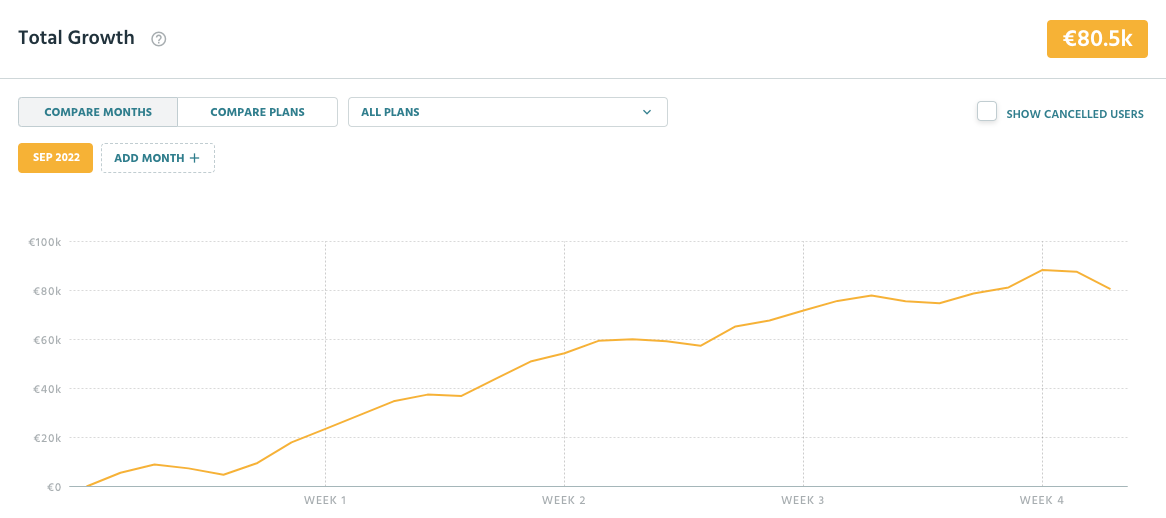
It feels like even though we haven't solved all our issues, we're on track to re-activating our momentum 🚀
We've been working in secret for months to launch some game-changer projects in the coming months like:
- lemlist v4 (A brand new version of lemlist 🤩)
- Moving our community to a dedicated platform with some key surprises
- A speaking tour in the US to talk about the future of sales
- A secret acquisition 🤩
- A project that will change the world of entrepreneurship 🚀
The challenges we faced are probably the ones that will create our story in the long run and as we say:
Sometimes when you're in a dark place you think you've been buried, but you've actually been planted.
Let me tell you that our plan is to become the biggest tree ever planted on planet earth 🌴
Love ❤️
G.

